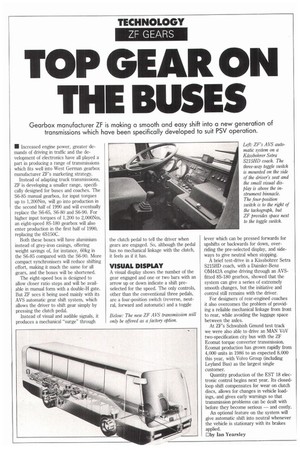TOP GEAR ON THE BUSES
Page 46

If you've noticed an error in this article please click here to report it so we can fix it.
• Increased engine power, greater demands of driving in traffic and the development of electronics have all played a part in producing a range of transmissions which fits well into West German gearbox manufacturer ZF's marketing strategy.
Instead of adapting truck transmissions, ZF is developing a smaller range, specifically designed for buses and coaches. The S6-85 manual gearbox, for input torques up to 1,200Nm, will go into production in the second half of 1990 and will eventually replace the S6-65, S6-80 and 56-90. For higher input torques of 1,200 to 2,000Nm, an eight-speed 85-180 gearbox will also enter production in the first half of 1990, replacing the 6S150C.
Both these boxes will have aluminium instead of grey-iron casings, offering weight savings of, for instance, 60kg in the S6-85 compared with the 56-90. More compact synchronisers will reduce shifting effort, making it much the same for all gears, and the boxes will be shortened.
The eight-speed box is designed to allow closer ratio steps and will be available in manual form with a double-H gate. But ZF sees it being used mainly with its AVS automatic gear shift system, which allows the driver to shift gear simply by pressing the clutch pedal.
Instead of visual and audible signals, it produces a mechanical "surge" through A visual display shows the number of the gear engaged and one or two bars with an arrow up or down indicate a shift preselected for the speed. The only controls, other than the conventional three pedals, are a four-position switch (reverse, neutral, forward and 'automatic) and a toggle Below: The new ZF AVS transmission will only be offered as a factory option. lever which can be pressed forwards for upshifts or backwards for down, overriding the pre-selected display, and sideways to give neutral when stopping.
A brief test-drive in a Kfissbohrer Setra S215HD coach, with a Daimler-Benz 0M442A engine driving through an AVSfitted 85-180 gearbox, showed that the system can give a series of extremely smooth changes, but the initiative and control still remains with the driver.
For designers of rear-engined coaches it also overcomes the problem of providing a reliable mechanical linkage from front to rear, while avoiding the luggage space between the axles.
At ZF's Schwabish Gmund test track we were also able to drive an MAN V8V two-specification city bus with the ZF Ecomat torque converter transmission. Ecomat production has grown rapidly from 4,000 units in 1986 to an expected 8,000 this year, with Volvo Group (including Leyland Bus) as the largest single customer.
Quantity production of the EST 18 electronic control begins next year. Its closedloop shift compensates for wear on clutch discs, allows for changes in vehicle loadings,, and gives early warnings so that transmission problems can be dealt with before they become serious — and costly.
An optional feature on the system will give automatic shift into neutral whenever the vehicle is stationary with its brakes applied.
Oby Ian Yearsley














































































































































































